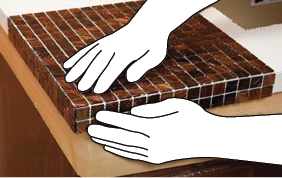Installation Notes
This is intended only as a quick reference to the basics of tile installation.
Tape is adhered to the front face of the mosaic sheets. Do not install this side into the setting material.
Carefully read all instructions before starting installation.
Please read and follow all specific installation products guidelines and specifications.
Installation should be performed in air temperatures between 41oF minimum and 86oF maximum.
Remember the space between sheets should equal the space between tiles.
Carefully assess the installation surface remembering that different substrates can require different preparation.
Installation surface should be a smooth uniform plane. Installation on a highly varied surface will be difficult and may cause undesirable results. Scored drywall of newly-built wall preferred substrate.
For newly-built wall applications, the walls drywall is an adequate substrate to receive the mosaic.
For existing wall or floor applications where the surface is structurally questionable or has a highly varied plane that will compromise the mosaic installation, add a layer of backer board, such as Durock, to serve as the substrate to receive the mosaic.
If possible, dry fit mosaic sheets and inspect before installing.

The installation surface must be smooth and clean to ensure proper installation.
It may be necessary to lay a thin layer of setting material on the surface to ensure that it is ready for the tile.
Allow 12 hours to dry if layer of setting material is needed.
NOTE: A waterproofing/anti-fracture membrane needs to be applied to the uniform surface if the mosaic is to be submerged in water, or if anti-fracture or crack isolation properties are necessary. This typically consists of rolling or spraying a liquid, rubber membrane onto the uniform surface prior to mosaic installation.

Measure the space in which the mosaic is being installed to determine the best fit for your tile.
Use a straight edge and level to help you align the tile as you work.
Construct a grid on the substrate that is equal to nine sheets of the tile.
NOTE: Be sure to account for the spaces between each sheet of tile when measuring.

Mix setting material.
First coat: apply setting material with the smooth edge of a trowel to a section no larger
than one section of the grid.
Second coat: create even ridges in the setting material by "combing" the material with the notched edge of the trowel.

The sheets of mosaic have a clear tape covering on the front face of the tile. This allows the mosaic design to be seen during installation.
Apply the backside of each sheet into the setting material, with the tape side face out.
Using a float tool, tap across the surface to adhere the mosaic securely into the setting material.
NOTE: The space between each sheet of tile should equal the space between each individual tile.

It is important to create a secure bond between the tiles and the setting material.
Using the float tool tap across the surface to adhere the mosaic securely.
This also ensures the final exposed plane of the mosaic is consistent and uniform in height.

This can be a time consuming process, but is important to ensure a professional installation.
Adjust while material is still wet.
Adjust any tiles that are uneven and ensure that all gaps are of equal width and height. Do this by cutting through the clear tape and moving tiles with a small trowel.

Grout can be applied to a clean, dry surface.
Before applying grout be sure that the mosaic surface is clean and all clear tape is removed from the tiles.
Peel tape in a diagonal motion.
Thorough cleaning may involve removing excess setting material from the mosaic's joint with a knife, as well as cleaning off all dust and particles.
Mix the grout and spread from the bottom up in a diagonal direction using a small trowel.
Squeegee in the opposite direction.

Expansion joints should be installed at all "changes in plane" of the mosaic and where the mosaic meets an adjoining surface, such as in a corner. Fill these spaces with a silicone caulking sealant in place of grout to create expansion joints at these locations.

The mosaic should be ready to be cleaned about 30-60 minutes after grouting.
Use a sponge and clean water and scrub in a circular motion, removing excess grout and smoothing all joints. Continue to wipe down the tiles until clean.
NOTE: Cleaning methods vary based upon the type of grout used in the installation. For example, a urethane grout must be cleaned earlier and more frequently that cementitious grout.
These above installation methods are suggested and based on our own technical experiences. It is for your reference only. No warranty is implied. For best results, please hire a professional tile installer experienced in the application of glass mosaic tiles, porcelain mosaic tiles, or mother of pearl tiles.
Also, you can refer to an official glass tile installation instruction from the CTIOA (Ceramic Tile Institute of America). The following link provides you with CTIOA PORT 2002-4-25* http://www.ctioa.org/reports/fr93.html